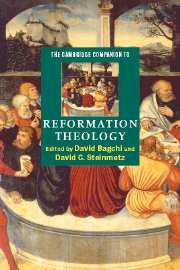Book contents
- Frontmatter
- Introduction
- 1 Late medieval theology
- 2 Lollardy
- 3 Hussite theology and the law of God
- 4 The theology of Erasmus
- 5 Luther
- 6 Melanchthon
- 7 Confessional Lutheran theology
- 8 The theology of Zwingli
- 9 Bucer
- 10 The theology of John Calvin
- 11 John Calvin and later Calvinism
- 12 The theology of Thomas Cranmer
- 13 The theology of the English reformers
- 14 The Scottish Reformation
- 15 An introduction to Anabaptist theology
- 16 Catholic theologians of the Reformation period before Trent
- 17 The Council of Trent
- Conclusion
- Select bibliography
- Index
- Series list
7 - Confessional Lutheran theology
Published online by Cambridge University Press: 28 May 2006
- Frontmatter
- Introduction
- 1 Late medieval theology
- 2 Lollardy
- 3 Hussite theology and the law of God
- 4 The theology of Erasmus
- 5 Luther
- 6 Melanchthon
- 7 Confessional Lutheran theology
- 8 The theology of Zwingli
- 9 Bucer
- 10 The theology of John Calvin
- 11 John Calvin and later Calvinism
- 12 The theology of Thomas Cranmer
- 13 The theology of the English reformers
- 14 The Scottish Reformation
- 15 An introduction to Anabaptist theology
- 16 Catholic theologians of the Reformation period before Trent
- 17 The Council of Trent
- Conclusion
- Select bibliography
- Index
- Series list
Summary
Martin Luther’s followers first defined themselves as a church through the Augsburg Confession of 1530, which was composed by Luther’s Wittenberg colleague Philipp Melanchthon to explain the introduction by certain princes and cities of the German empire of ecclesiastical reforms in accord with Luther’s theology. This confession not only served as a legal document defining the teaching of the churches of these governments for the emperor Charles V but also quickly became a guide for public teaching for Luther’s adherents. Melanchthon’s defence of its contents in his Apology of 1531, the Schmalkaldic Articles of faith (composed by Luther in 1537 as an agenda for confession at the papal council called in 1536), Luther’s Large and Small Catechisms, and the Formula of Concord of 1577 were brought together with the Augsburg Confession and the ancient creeds as the summary definition of the faith for Lutheran churches in the Book of Concord of 1580. Seldom cited in theological argumentation during the period, these documents nonetheless provided the legal and theological parameters within which Lutheran theologians expressed and explored their faith. These documents mark the path of Lutheran theological confessionalization.
- Type
- Chapter
- Information
- The Cambridge Companion to Reformation Theology , pp. 68 - 79Publisher: Cambridge University PressPrint publication year: 2004
- 1
- Cited by



